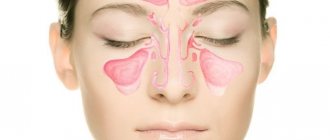Causes
The development of catarrhal rhinitis most often occurs in the cold season, when the human body becomes most vulnerable to the adverse effects of the external environment. For the most part, the trigger for the formation of pathological processes is cold or contact with people who are infected with any viral infection.
With proper breathing, the nasal cavity is the first “bastion” that various pathogenic factors must overcome in order to enter the body. Viral and bacterial particles, allergens, and dust pass through it. All these agents negatively affect the mucous membrane, causing inflammation in it with subsequent circulatory disorders. The result is the development of the disease.
The following factors contribute to the appearance of symptoms of catarrhal rhinitis:
- the entry into the patient’s body of a large number of pathogenic microorganisms or viral particles, which can occur during prolonged contact with an infected person;
- high ability of the infection to infect (virulence);
- regular exposure to cold;
- chronic infectious processes in the organs of the ENT system;
- the presence of chronic pathologies that inevitably lead to a weakening of the body’s immune defense;
- malnutrition, lack of the required amount of vitamins in food;
- stressful influences.
Chronic catarrhal rhinitis is a consequence of the lack of timely treatment of the acute form of the disease.
Causes of the disease
The etiology of chronic catarrhal rhinitis is associated with a constant runny nose. The main provoking factors include the following:
- allergy;
- lack of minerals and vitamins;
- presence of bad habits;
- work in hazardous production;
- penetration of microbes and viruses;
- diathesis in young children;
- poor nutrition;
- constant hypothermia;
- stress.
In addition, there may be other causes of catarrhal chronic rhinitis, which include the following:
- sinusitis;
- narrow nasal passages;
- deformation of the nasal septum.
It often occurs with difficulty breathing, since much less oxygen is supplied. Because of this, a kind of greenhouse effect occurs, resulting in a favorable environment for the development of bacteria.
Symptoms
Catarrhal rhinitis is a disease whose symptoms are very well known to many people. Pathology can be determined based on the following simple signs:
- the presence of a feeling of itching in the nasal passages, which cannot be relieved by anything;
- unpleasant feeling of dry mucous membranes;
- the inability to breathe through the nose, due to which the mucous membrane of the mouth quickly dries out, since the person is forced to inhale and exhale with its help;
- decreased or complete absence of the ability to smell;
- lacrimation;
- changes in voice timbre;
- decreased performance, weakness, fatigue, deterioration in general health;
- lack of appetite;
- headache attacks.
If you have developed a cold accompanied by rhinitis, then you should not be surprised by symptoms of the disease such as muscle aches, increased body temperature, and dyspeptic symptoms in some cases (for example, nausea, vomiting). Read more about the symptoms of rhinitis →
Causes and symptoms of the disease
Often, a large number of bacteria and pathogenic microorganisms penetrate into our body, and in particular into the nasal cavity. If a person’s immune system is in perfect order, the body can easily cope with all incoming infections. If the immune system is weakened, catarrhal rhinitis occurs quite often.
The next reason for the development of catarrhal rhinitis is hypothermia. The reasons may also include a lack of microelements and vitamin deficiency.
At the initial stage of the disease, a person feels dryness and burning in the nose. In some cases, headache, weakness, and general malaise appear. As the disease progresses, the overall patency of the nasal cavity decreases and the sense of smell deteriorates.
A couple of days after the onset of the disease, increased mucus secretion appears, and nasal breathing becomes very difficult. Subsequently, the mucous discharge acquires a greenish-yellow tint and becomes thicker, which leads to the formation of crusts.
The main symptoms of catarrhal rhinitis:
- difficulty breathing through the nose;
- mucous discharge from the nose;
- nasality;
- deterioration of sense of smell;
- headache;
- sneeze.
Forms
If the patient has developed any signs of catarrhal rhinitis, it is necessary to determine the form of the disease in order to select the most optimal treatment regimen.
There are acute and chronic catarrhal rhinitis:
- Acute catarrhal rhinitis is most often a consequence of human contact with infectious agents. Its symptoms are pronounced: there is discomfort in the nasal passages, the inability to breathe through the nose, and attacks of sneezing and watery eyes. Since the disease is often caused by pathogenic microflora or viruses entering the body, there is also a general deterioration in the condition. The person complains of weakness, lethargy, sleep disturbances, and headaches. Gradually, the nasal discharge becomes not transparent, but yellowish or green. This indicates the accession of pathogenic microflora to the processes and the transition of catarrhal rhinitis to purulent. The last stage of the disease is the formation of unpleasant crusts that tighten the mucous membrane.
- Chronic catarrhal rhinitis. This form of the disease is diagnosed if the patient’s symptoms of a runny nose do not go away for three months or more. Chronicity of the process is a consequence of insufficient or improper treatment of the disease at the initial stages of its development. Chronic rhinitis of the catarrhal type is usually characterized by long periods of remission, accompanied by exacerbations. During exacerbations, the patient complains of the inability to breathe through the nose, sneezing, itching in the nasal passages, and lacrimation. Symptoms of general malaise are most often absent.
Catarrhal rhinitis
Rhinitis
is one of the most common diseases in the world; it is characterized by inflammation of the nasal mucosa, accompanied by mucus secretion, deterioration of nasal breathing, decreased sense of smell, and headache.
Acute catarrhal rhinitis
Initially manifested by a feeling of dryness, burning and itching in the nasal cavity, sneezing, general weakness, possible pain in muscles and joints.
The discomfort gradually turns into nasal congestion with a reduced sense of smell, this is the so-called first stage of rhinitis. In the second stage, mucus accumulates in the nasal cavity and is released from the nose, making nasal breathing even more difficult. As a rule, during this period, appetite is reduced, sleep is disturbed, and headaches may occur. The patient begins to breathe through his mouth, which contributes to the spread of inflammation to the lower respiratory tract and the development of complications. After 2–4 days, nasal discharge becomes viscous, crusts form, and it becomes increasingly difficult to blow your nose; this is the third stage of rhinitis. If rhinitis is not treated promptly, serious complications can occur. Timely diagnosis of rhinitis using modern research methods is extremely necessary. When examining a patient, an otolaryngologist should prescribe an x-ray of the paranasal sinuses and conduct an endoscopic examination of the nasal cavity, nasopharynx, ultrasound of the paranasal sinuses (in young children, pregnant women), and a laboratory study of the cellular composition of nasal secretions. Treatment of
acute catarrhal rhinitis is carried out on an outpatient basis; patients are advised to stay at home; it is better to be in a room with warm and humidified air, this reduces the feeling of dryness, tension and burning in the nose. The diet should not be irritating; drug therapy is prescribed: the use of vasoconstrictors and antibacterial drugs, drugs that help reduce the viscosity of mucus in the nasal cavity, irrigation of the nasal cavity with saline solutions. It is also necessary to carry out a modified rinse of the nasal cavity with saline solutions and a 0.01% solution of miramistin, this promotes rapid recovery.
Chronic catarrhal rhinitis
the result of untreated acute rhinitis, as a result, microorganisms penetrate deeply into the thickness of the mucous membrane, causing pronounced destructive changes in it, and reducing its protective (immunological) function.
Most often, patients complain of mucous discharge from the nose, difficulty in nasal breathing, alternating congestion of both halves of the nasal cavity, decreased sense of smell, often headache, mucus running down the back of the throat, snoring. In the treatment of catarrhal
chronic rhinitis, astringents and irrigation of the nasal cavity with saline solutions are prescribed. To improve drainage of the sinuses, anemization of the nasal mucosa and rinsing of the nasal cavity using a modified moving method are performed. At the same time, it is recommended to carry out thermal procedures on the nose, UHF or microwaves and endonasally UV (ultraviolet).
Which doctor treats catarrhal rhinitis?
Which doctor is competent to treat the disease? Most often, general practitioners have to deal with getting rid of patients from pathology, since patients with colds are seen by them.
In addition to the therapist, a person can also contact an ENT specialist, who is more competent in the treatment of nasal diseases than a therapist. At the discretion of the attending physician, allergists, infectious disease specialists, and immunologists may also be invited to consultations. Their participation in the treatment process is necessary in order to influence the disease with a set of measures, which is considered a more effective approach.
Diagnostics
Before starting any treatment, the patient needs to be properly diagnosed. Diagnosis begins with a general medical examination. During it, the specialist pays attention to the condition of the face in general and the nasal area in particular, and clarifies with the patient exactly what complaints are bothering him. It is imperative to evaluate the skin and visible mucous membranes for the presence of injuries, cracks, boils and other damage.
The second stage of diagnosis is rhinoscopy. During it, the doctor examines the nasal passages from the inside, paying attention to those mucous membranes that cannot be seen with the naked eye. Blocking of the nasal passages with accumulations of mucus is one of the signs of catarrhal rhinitis. Swelling and inflammation of the nasal passages are also noteworthy.
If hypertrophic rhinitis is suspected, the mucous membranes are lubricated with a special solution. If under its influence the swelling subsides, then the diagnosis is rejected and it becomes possible to diagnose the catarrhal form of the disease.
The doctor also draws attention to the fact that there is no unpleasant odor in the nasal passages. If there is a smell, then you should suspect the development of a bacterial infection.
Complications after rhinitis
If you neglect treatment, then rhinitis, no matter what form, can cause complications in all organs of the respiratory system.
For example, acute catarrhal rhinitis can cause the following diseases:
- pharyngitis;
- laryngitis;
- inflammation of the maxillary sinuses (sinusitis);
- otitis;
- bronchitis;
- pneumonia.
Chronic catarrhal rhinitis can also lead to the above diseases. In addition to them, advanced chronic runny nose can be complicated by sinusitis or pneumonia.
Pharyngitis, laryngitis and pneumonia develop with rhinitis due to the fact that due to difficulty breathing a person is forced to breathe through the mouth. Reduced immunity contributes to the rapid proliferation of various viruses and bacteria, since the body does not have strong respiratory protection.
Do not under any circumstances cause rhinitis! This threatens with serious consequences that are much more difficult and longer to cure. There is no need to delay your visit to the doctor. Only a qualified specialist will select the most optimal treatment option.
There is also no need to brush aside preventive procedures. This is a serious help in the fight against a runny nose. By the way, this fact has been proven by science.
Next Post
Previous Post
Treatment
Treatment of the pathology must begin as soon as its first signs appear. Before the disease fully develops, the patient can take the following measures to ease its course:
- carry out regular ventilation in the room;
- humidify the air in the workroom and bedroom;
- drink a lot and often;
- Eat well and consume enough vitamin C.
If the disease is caused by prolonged exposure to the cold, treatment can begin with warming the nose with a special blue lamp and warm foot baths. True, if the pathology is caused by a virus, such methods will be useless.
Drug treatment is prescribed by a doctor and includes a wide range of different drugs. Among them:
- vasoconstrictors designed to quickly relieve nasal congestion (Xylometazoline, Naphazoline, etc.);
- rinsing the nose with special solutions (Aqualor, Physiomer, etc.);
- antiseptic and astringent agents that will eliminate bacterial rhinitis (Miramistin);
- local interferon preparations (Grippferon).
If necessary, antipyretics, antihistamines and immunomodulators are additionally prescribed. All patients are prescribed vitamin therapy.
Prevention
Preventing the development of catarrhal rhinitis is much easier than treating it later. First of all, in order to prevent the development of the disease, it is recommended to avoid cold and contact with sick people, as these are the main factors leading to the development of the disease.
Timely elimination of chronic infectious foci in the ENT organs will help reduce the likelihood of developing inflammation in the nasal passages. Strengthening the immune system through rational hardening, exercise, and vitamin therapy will help prevent pathology.
If we are talking about a small child, it is sometimes recommended that they have their adenoids removed, since they can be the cause of the development of chronic catarrhal rhinitis. To prevent the disease from becoming chronic, it is necessary to promptly and fully treat it.
Catarrhal rhinitis is a common and unpleasant pathology that anyone can encounter. When the first symptoms of the disease appear, it is recommended to consult a doctor to prevent the disease from becoming chronic. Timely treatment of rhinitis is the key to a good quality of life. After all, proper nasal breathing is an important element necessary for maintaining health.
Author: Arina Volkova, doctor, especially for Moylor.ru
General treatments
Treatment of catarrhal rhinitis is carried out using conservative methods, excluding surgical intervention. Therapy is aimed at eliminating the symptoms and the underlying disease that provoked the development of a runny nose.
Decongestants
To eliminate the main symptom, nasal congestion, drugs from the group of decongestants with vasoconstrictor action are prescribed. They have an immediate effect by normalizing nasal breathing, however, they can be used for no longer than a week, since these drugs are addictive and can subsequently lead to atrophy of the nasal mucosa. Often used medications are Naphthyzin, Noxprey, Nazivin, Rinostop, and others.
In addition, astringents are used for local therapy; Protargol 1.5% or Collargol is used to eliminate nasal leakage.
Irrigation
It is also recommended to carry out regular irrigation of the nasal cavity and throat, for this they use saline and antiseptic solutions, herbal decoctions (chamomile, sage, calendula, etc.). Inhalation nebulizer or steam treatment using essential oils of eucalyptus, fir, and mint may be prescribed.
Medicines
Depending on what caused the runny nose (viruses, allergens or viral-bacterial infection), antiviral, antihistamine, and antibacterial drugs are prescribed.
For a chronic disease, in addition to medications, the doctor recommends taking a course of physiotherapy - Sollux, UHF, UV therapy, microwave therapy.
Do not underestimate the common runny nose; timely treatment will protect you from chronicity of the disease and prevent complications.










